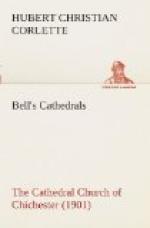[3] Walcott, “Early Statutes,”
p. 15.
[4] Walcott, p. 15.
But apart from these many indications of activity, the fabric as it stands to-day speaks very clearly of the amount of building that went on between 1200 and 1300. But it was not till 1288-1305 that Bishop Gilbert de S. Leophardo had added the two new bays of the lady-chapel eastward.
The fire was the direct cause of most of the work that was done. There was another, however; for eleven years after the re-dedication, two of the towers fell. It has been supposed by some that these must have been the early towers of the west front, both of which still preserve indications of having been begun during the twelfth century as part of the original building scheme. It is probable, for reasons that will appear later, that the two towers of the west front did not collapse at the time of the second fire, although it would seem from the Chronicle of Dunstable that their stability may have been impaired in some measure, since the sole cause for this fall of towers is given in the words “impetu venti ceciderunt duae turres Cicestriae.” [5] But if these towers had been affected, what of the original central tower? Its risk of receiving serious damage would be far greater. That no more than the upper story of one of these can have fallen is evident from the fact that the south-western tower presents for examination to this day its original base, and the nature of the upper part of this same tower shows that it was rebuilt anew daring the first half of the thirteenth century. It was necessary that the two towers at the west as well as the central tower should be finished up to a certain level, for, placed as they were upon the plan, they became essential parts of the structure, whose absence would diminish the strength of the whole; hence any desire to maintain the fabric satisfactorily would require that those of them which fell should receive the immediate attention of the builders. In the case of the south-west




